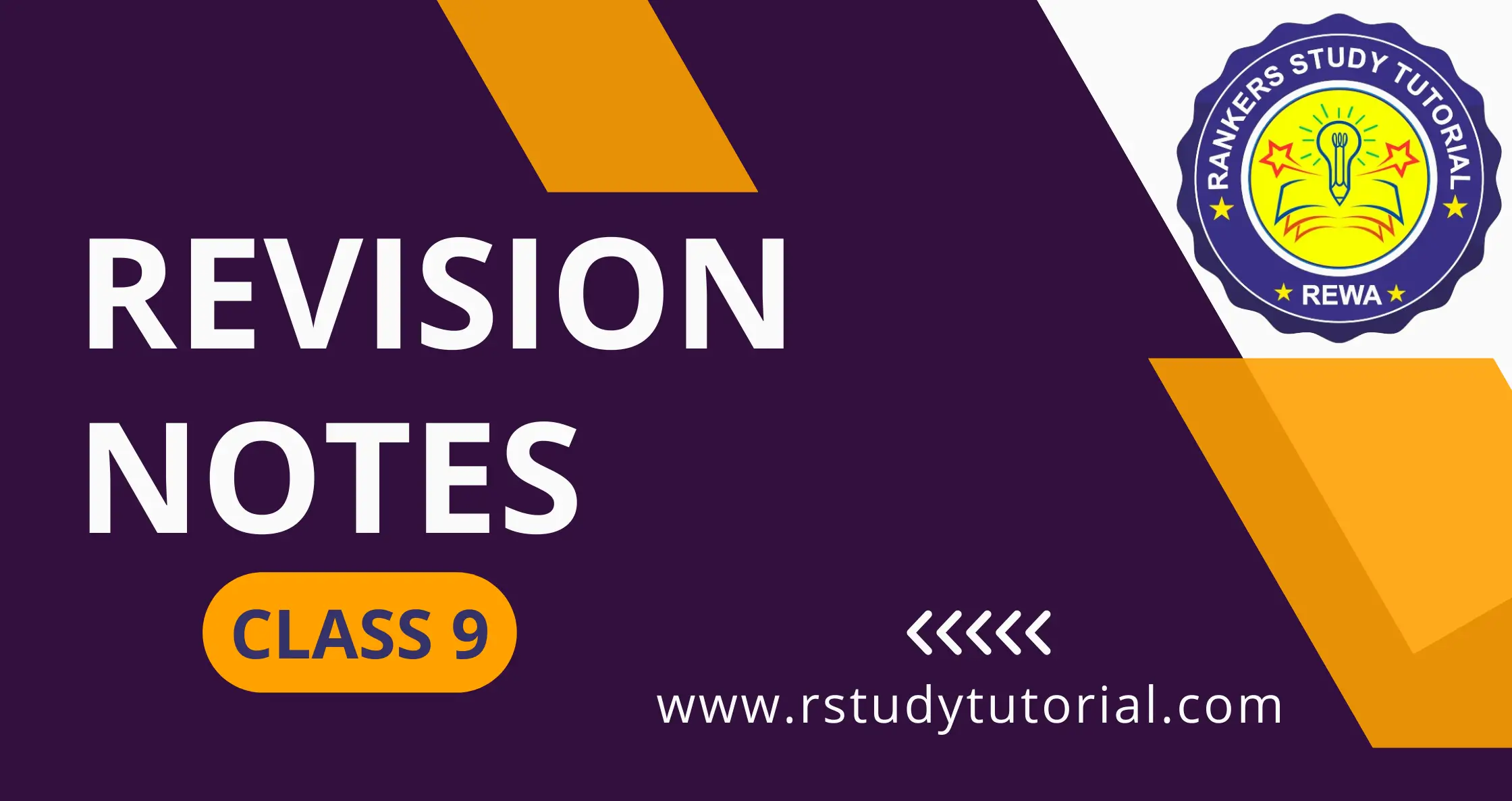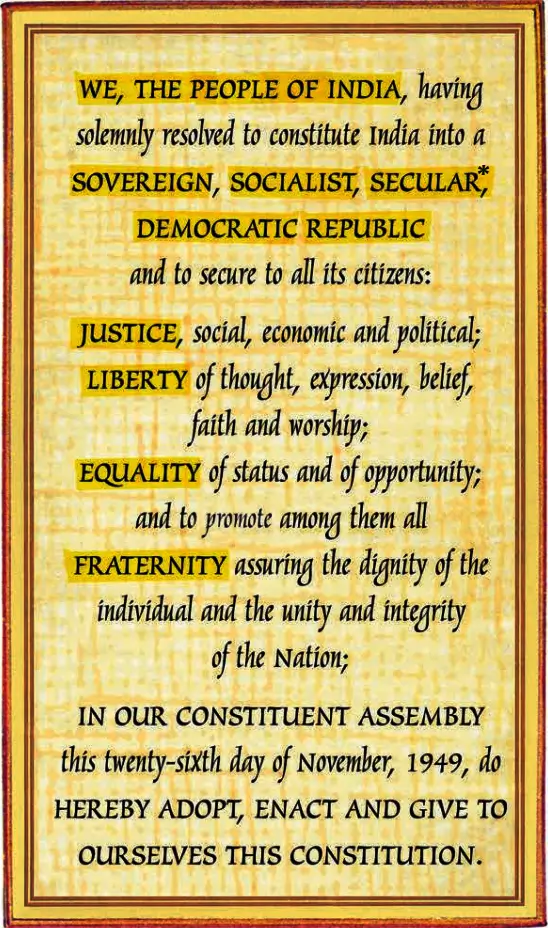Revision Notes for Class 9 Political Science Chapter 2 Constitutional Design
Revision notes of Constitutional design will help students to understand the constitutions of India. The notes for revision of Constitutional design is prepared in keeping in mind that gist of whole chapter will cover. Students will able to understand the basic rules and basic rights in revision notes of Constitutional design that are available to citizen of India.
There are certain basic rules that the citizens and the government have to follow. All such rules together are called constitution. Constitution is the supreme law that determines the rights of citizens, the powers of the government and how the government should function.
Revision notes of Functions of the Constitution
- It generates a degree of trust and coordination that is necessary for different kind of people to live together.
- It specifies how the government will be constituted and who will have power to take which decisions.
- It lays down limits on the powers of the government and gives the rights of the citizens.
- It expresses the aspirations of the people about creating a good society.
History of other countries Constitution
- After the War of Independence against Great Britain, the Americans gave themselves a constitution.
- After the Revolution, the French people approved a democratic constitution. Since then it has become a practice in all democracies to have a written constitution.
Making of Indian Constitution: A Difficult Task
- Difficult circumstances: Constitution making for a huge and diverse country like India was not an easy affair as people of India were emerging from the status of subjects to that of citizens.
- Painful partition: The country was born through a partition on the basis of religious differences. At least ten lakh people were killed on both sides of the border in partition related violence.
- Issues in merging of Princely States: The British had left it to the rulers of the princely states to decide whether they wanted to merge with India or with Pakistan or remain independent. The merger of these princely states was a difficult and uncertain task.
The path to Constitution
- Consensus: Much of the consensus about democratic India had evolved during the freedom struggle.
- Some basic ideas accepted by almost everyone during national movement:
- As far back as in 1928, Motilal Nehru and eight other Congress leaders drafted a Constitution for India.
- In 1931, the resolution at the Karachi session of the Indian National Congress dwelt on how independent India’s constitution should look like.
- Both these documents were committed to the inclusion of universal adult franchise, right to freedom and equality and to protecting the rights of minorities in the Constitution of independent India.
- Familiarity with political institutions of colonial rule:
- It also helped develop an agreement over the institutional design. Though their institutional design was not fully democratic in 1937 elections, but the experience gained by Indians in the working of the legislative institutions proved to be very useful for the country in setting up its own institutions and working in them. That is why the Indian Constitution adopted many institutional details and procedures from colonial laws like the Government of India Act, 1935.
- Our leaders gained confidence to learn from other countries, but on our own terms:
- Many of our leaders were inspired by the ideals of French Revolution, the practice of parliamentary democracy in Britain and the Bill of Rights in the US.
- The socialist revolution in Russia had inspired many Indians to think of shaping a system based on social and economic equality.
Revision notes of The Constituent Assembly
- The drafting of the document called the Constitution was done by an assembly of elected representatives called the Constituent Assembly.
- Elections to the Constituent Assembly were held in July 1946. Its first meeting was held in December 1946.
- It was elected mainly by the members of the existing Provincial Legislatures.
- After partition of India:
- The country was divided into India and Pakistan. The Constituent Assembly was also divided into the Constituent Assembly of India and that of Pakistan.
- The Constituent Assembly that wrote the Indian constitution had 299 members.
- The Assembly adopted the Constitution on 26 November 1949, but it came into effect on 26 January 1950.
Reasons for acceptance of the Constitution
- Broad consensus: The Constitution does not reflect the views of its members alone but expresses a broad consensus of its time.
- Constituent Assembly – Represented the people of India:
- Fair geographical share from all regions of country: Though, there was no universal adult franchise at that time, but the Constituent Assembly was elected mainly by the members of the existing Provincial Legislatures.
- The Assembly was dominated by the Indian National Congress, the party that led India’s freedom struggle. But the Congress itself included a variety of political groups and opinions. The Assembly also had many members who did not agree with the Congress.
- In social terms: The Assembly represented members from different language groups, castes, classes, religions and occupations.
- Manner in which the Constituent Assembly worked gives sanctity to the Constitution:
- The Constituent Assembly worked in a systematic, open and consensual manner.
- First some basic principles were decided and agreed upon. Then a Drafting Committee chaired by Dr. B.R. Ambedkar prepared a draft constitution for discussion.
- Deliberation:
- Several rounds of thorough discussion took place on the Draft Constitution, clause by clause.
- More than two thousand amendments were considered.
- The members deliberated for 114 days spread over three years. Every document presented and every word spoken in the Constituent Assembly has been recorded and preserved. These are called ‘Constituent Assembly Debates’. These debates provide the rationale behind every provision of the Constitution. These are used to interpret the meaning of the Constitution.
Revision notes of Guiding values of the Indian Constitution
Philosophy of the Constitution
- Values that inspired and guided the freedom struggle and were in turn nurtured by it, formed the foundation for India’s democracy. These values are embedded in the Preamble of the Indian Constitution.
- They guide all the 28 Articles of the Indian Constitution.
Preamble![Revision Notes Class 9 Political Science Chapter 2 Preamble]()
Institutional Design
- A constitution is not merely a statement of values and philosophy but about embodying these values into institutional arrangements. Much of the document called the Constitution of India is about these arrangements.
- Constitutional Amendment:
- The Constitution is a very long and detailed document. Therefore, it needs to be amended quite regularly to keep it updated.
- The Constitution makers felt that it has to be in accordance with people’s aspirations and changes in society.
- They did not see it as a sacred, static and unalterable law. So, they made provisions to incorporate changes from time to time. These changes are called constitutional amendments.
Some Great Personalities and their Contribution
| Vallabhbhai Jhaverbhai Patel (1875-1950) | Born: Gujarat. Minister of Home, Information and Broadcasting in the Interim Government. Lawyer and leader of Bardoli Peasant Satyagraha. Played a decisive role in the integration of the Indian princely states. Later: Deputy Prime Minister |
| Abul Kalam Azad (1888-1958) | Born: Saudi Arabia. Educationist, author and theologian; scholar of Arabic. Congress leader, active in the national movement. Opposed Muslim separatist politics. Later: Education Minister in the first union cabinet. |
| T. T. Krishnamachari (1899-1974) | Born: Tamil Nadu. Member, Drafting Committee. Entrepreneur and Congress leader. Later: Finance Minister in the Union Cabinet. |
| Rajendra Prasad (1884-1963) | Born: Bihar. President of the Constituent Assembly. Lawyer, known for his role in the Champaran satyagraha. Three times the President of Congress. Later: the first President of India. |
| Jaipal Singh (1903-1970) | Born: Jharkhand. A sportsman and educationist. Captain of the first national Hockey team. Founder President of Adivasi Maha Sabha. Later: founder of Jharkhand Party. |
| H. C. Mookherjee (1887-1956) | Born: Bengal. Vice-Chairman of the Constituent Assembly. Reputed author and educationist. Congress leader. Member of All India Christian Council and Bengal Legislative Assembly. Later: Governor of West Bengal. |
| G. Durgabai Deshmukh (1909-1981) | Born: Andhra Pradesh. Advocate and public activist for women's emancipation. Founder of Andhra Mahila Sabha. Congress leader. Later: Founder Chairperson of Central Social Welfare Board. |
| Baldev Singh (1901-1961) | Born: Haryana. A successful entrepreneur and leader of the Panthic Akali Party in the Punjab Assembly. A nominee of the Congress in the Constituent Assembly. Later: Defence Minister in the Union Cabinet. |
| Kanhaiyalal Maniklal Munshi (1887-1971) | Born: Gujarat. Advocate, historian and linguist. Congress leader and Gandhian. Later: Minister in the Union Cabinet. Founder of the Swatantra Party. |
| Bhimrao Ramji Ambedkar (1891-1956) | Born: Madhya Pradesh. Chairman of the Drafting Committee. Social revolutionary thinker and agitator against caste divisions and caste-based inequalities. Later: Law Minister in the first cabinet of post-independence India. Founder of Republican Party of India. |
| Shyama Prasad Mukherjee (1901-1953) | Born: West Bengal. Minister for Industry and Supply in the Interim Government. Educationist and lawyer. Active in Hindu Mahasabha. Later: Founder President of Bharatiya Jansangh. |
| Jawaharlal Nehru (1889-1964) | Born: Uttar Pradesh. Prime Minister of the interim government. Lawyer and Congress leader. Advocate of socialism, democracy and anti-imperialism. Later: First Prime Minister of India. |
| Sarojini Naidu (1879-1949) | Born: Andhra Pradesh. Poet, writer and political activist. Among the foremost women leaders in the Congress. Later: Governor of Uttar Pradesh. |
| Somnath Lahiri (1901-1984) | Born: West Bengal. Writer and editor. Leader of the Communist Party of India. Later: Member of West Bengal Legislative Assembly. |
Interesting points
● Nelson Mandela:
⮚ He was tried for treason by the white South African government and sentenced to life imprisonment in 1964 for daring to oppose the apartheid regime in his country.
⮚ He spent the next 28 years in South Africa’s most dreaded prison, Robben Island.
⮚ He was the first President of new South Africa.
⮚ At the midnight of 26 April 1994, the new national flag of the Republic of South Africa was unfurled.
● Apartheid: It was the name of a system of racial discrimination unique to South Africa. The African National Congress (ANC) was the umbrella organisation that led the struggle against it.
● Mahatma Gandhi was not a member of the Constituent Assembly. His magazine was Young India.
● Preamble: The Constitution begins with a short statement of its basic values.
● Most countries have chosen to begin their Constitution by taking inspiration from American model. decision has to go through a series of consultations. Every office bearer has certain rights and responsibilities assigned by the constitution and the law.





